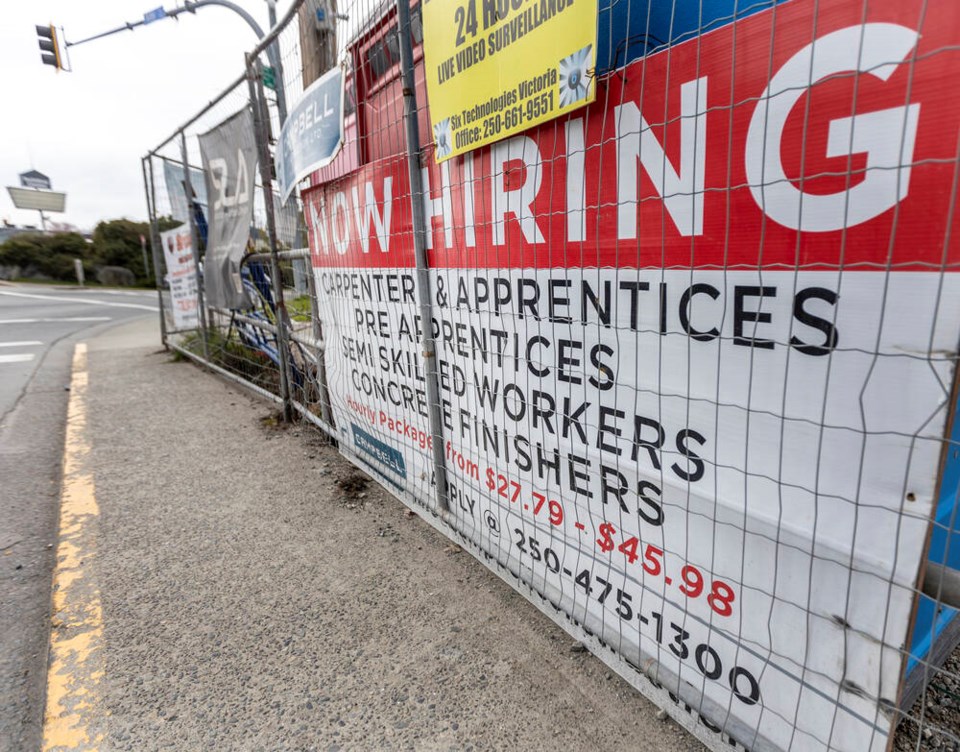Greater Victoria’s unemployment rate is the second-lowest in the country — something that will not come as a surprise to the many sectors begging for workers.
The capital region’s rate was 3.2 per cent in March, down slightly from 3.3 in February, and second only to Quebec City at just 1.7 per cent. Calgary had the highest unemployment rate in the country at 6.6 per cent last month, Statistics Canada said in its labour force survey released Thursday.
Labour shortages are widespread and expected to continue in Greater Victoria as workers retire. Help-wanted posters for hospitality workers are common, and construction worksites often feature large signs seeking skilled trades.
The number of people working in construction rose to 18,500 in March, from 17,300 the same month last year. Health-care and social-assistance employment climbed to 35,300 last month, from 33,700 a year earlier.
Accommodation and food services increased to 17,200 in March, up from 15,700 in March 2022.
Declines were seen in public administration, where employment dropped to 25,100 last month from 29,200 a year ago.
Manufacturing jobs slipped to 8,700 in March from 10,300 in March 2022. Wholesale and resale trade also dropped slightly to 6,900 from 6,200 year-over-year.
Province-wide, the unemployment rate dropped to 4.5 per cent in March from 5.1 per cent in February, making it the second-lowest in the country, behind Quebec at 4.2 per cent.
Brenda Bailey, B.C. Minister of Jobs, Economic Development and Innovation, said so far this year, the province has added 14,300 jobs, of which 5,300 are in the private sector.
Job numbers last month remained consistent “despite the ripple effects of global economic uncertainty that are being felt around the world,” she said.
The province is spending $480 million over three years to boost training in skilled trades and help businesses find and use technology.
Nationally, Canada’s economy added 35,000 jobs in March amid strong population growth, keeping the unemployment rate steady at near record lows. The unemployment rate came in at five per cent for the fourth consecutive month.
Job gains were made primarily in the private sector. Employment was up in transportation and warehousing, business, building and other support services, as well as finance, real estate, rental and leasing.
Meanwhile, jobs were lost in construction, other services and natural resources.
Brendon Bernard, a senior economist at Indeed, said the report shows the labour market is still doing well, “despite a lot of economic uncertainty.”
But Bernard cautioned that interpreting the job numbers is a bit tricky because Canada is also seeing its population grow rapidly.
Statistics Canada says the population grew by 0.3 per cent last month, while employment rose by 0.2 per cent.
“The report might not be quite as strong as the headline number might suggest,” Bernard said. “But at the same time, that five per cent unemployment rate highlights the big picture story, which is that the job market remains in solid shape.”
As employers kept their hiring appetite, wages continued to grow in March. Average hourly wages rose 5.3 per cent on an annual basis.
The Canadian labour market has been tight for months, despite high interest rates raising the cost of borrowing for people and businesses.
March marked the fourth consecutive month the unemployment rate has held at five per cent, hovering near record lows.
The Statistics Canada report showed those who are unemployed were less likely to stay out of work for a long time. The percentage of those who were unemployed in March that had been out of work for 27 weeks or more was 16 per cent, down from 20.3 per cent a year earlier.
However, the labour market tightness isn’t expected to last forever. The Bank of Canada’s aggressive rate hikes since March 2022 are expected to weigh on the economy, with economists forecasting a significant slowdown this year.
Recent surveys released by the central bank earlier this week showed consumers and businesses are preparing for that slowdown. Consumers said they’re planning to pull back on spending, while businesses are anticipating sales to slow.
That pullback is expected to filter through to the labour market and lead to a rise in unemployment.
And while businesses continued to report labour shortages as a top concern, the surveys showed there are signs that the labour market is easing.



